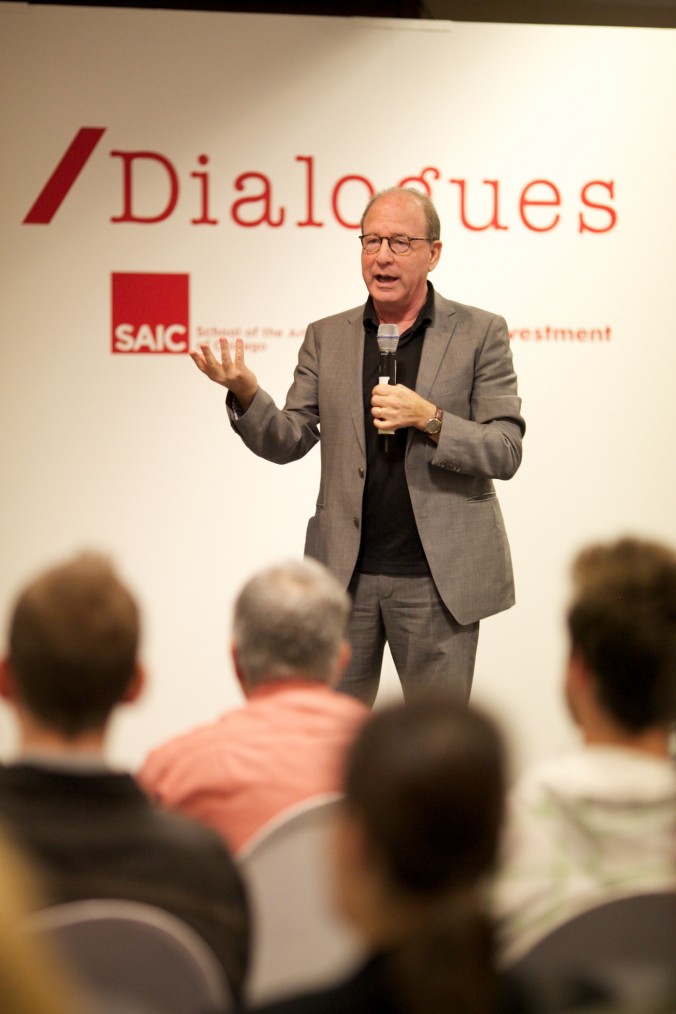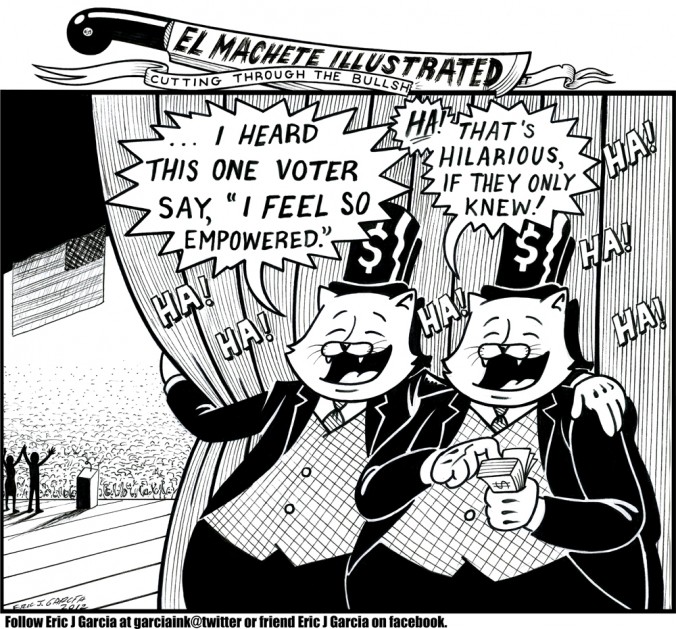* Feature image caption: Jerry Saltz and SAIC Dean Lisa Wainrightduring at EXPO Chicago. Image courtesy of EXPO.

“I view art fairs as cultural-biomasses: survival mechanisms where galleries act like great schools of fish, banding together in like groups that allow more to thrive,” opined art critic Jerry Saltz in an entry he wrote in conjunction with a New York Magazine’s feature titled “How to Make it in the Art World: The New Rulebook.”
Though the publication’s self-proclaimed “tongue-in-cheek” insider’s guide came off, as a whole clichéd, shortsighted and contrived, Saltz nonetheless managed to communicate somewhat insightful views about the ubiquitous phenomenon that is the contemporary art fair. “At art fairs, art becomes like millions of eggs released into water to have a better chance at being fertilized,” said Saltz. “This means that collectors are semen, but whatever.”
I would be reluctant to call Saltz a brilliant wordsmith, however, it might be worth it to entertain this metaphor for a moment. If the nature of the art fair renders an artwork as undeveloped potential waiting to be fulfilled by a healthy collector…er…swimmer, it could arguably follow that the critics are flagella, propelling collectors toward the prize (though Mr. Saltz might disagree). In the end, collectors just have to pray that they get a good egg with solid DNA that can endure today’s fickle art market.
With what I’ve gathered about this year’s EXPO Chicago (and life in general, I suppose) — When no one gets any action, everyone gets a little agitated and pretty self-conscious.
If art fairs can be seen as complex ecosystems, each with specific needs and characteristics, it means that they can thrive, change, or die depending on how the species and conditions within fit together or compete for survival.
In his article, Saltz was relatively cynical about what existing fairs have come to represent, but also unusually hopeful that the rise of new and diverse art fairs might point to a moment capable of breaking down what he sees as domineering commercial art world structures.
If these emerging events do, in fact, point to a revitalization of the art world, the question then becomes whether or not it is possible for less established fairs to compete and survive, without becoming what Saltz describes as “entertainment complexes for the one percent.”
Hired as the keynote speaker for the opening day of EXPO Chicago, Saltz brought these issues to bear on the city’s fledgling affair. In between pleasing the crowd with various recycled jokes — including the one about having so many honorary doctoral degrees that he could perform surgery — Saltz, true to form, said the things proud Chicagoans have been too afraid to talk about in terms of the much hyped spectacle at Navy Pier.
“Chicago is a real city with real galleries, real museums…but if collectors do not buy, this art fair cannot survive,” he said, “This is what I want, but I do not know that it can happen.”
As he doled out tips for artists in the crowd, it became clear that he wanted to direct the focus of the art fair away from the collectors and gallerists to reintroduce the importance of the artist and the seemingly lost notion of imagination and experimentation in these fêtes turned high-class carnivals for very “important people.”
Needless to say, he did not compromise his infamous say-it-like-it-is attitude for the occasion. Undoubtedly attended by a significant number of SAIC students who were given free admission to the fair, Saltz’s advice to avoid the unnecessary trap of expensive art schools may have been in vain.
Actually, many of the speakers and panelists included in “EXPO/Dialogues” — ongoing educational programming at the fair including a local and international range of artists, collectors, curators, gallerists, and academics, among others — were in fact alumni or faculty of fancy, overpriced schools.
Maybe a pricey school can’t make you a good artist, but surely you have a better chance at meeting the “100 people” that New York Magazine listed as art world must-knows in “How to Make it in the Art World: The New Rulebook. ” Come to think of it, Jerry Saltz, who happens to be the magazine’s resident art critic, was the only EXPO Chicago speaker who was on that list.
But this is Chicago, and like those stubborn New Yorkers, we have our own midwestern way of doing art. Or do we?
In a lively Expo dialogue between The Renaissance Society’s internationally recognized curator Hamza Walker, Chicago gallerist Andrew Rafacz of Andrew Rafacz Gallery, and Chicago collector and leading HIV specialist Daniel Berger, the conversation centered around the notion that Chicago’s contemporary art scene is beginning to shake the stigma that it is second rate or out of touch. And according to the panelists, it’s an exciting time and ideal place to be involved in art.
“Chicago’s art scene has become more robust in the past twenty years,” said Walker, “I don’t reflect on a certain Chicago-ness as I would have before — It’s a particularly beautiful moment.”
Rafacz and Berger concurred that the city’s upswing is, in part, due to a palpable de-centralization of activity in art, without losing necessary points of intersection and chances for intermingling within both institutional and independent realms.
“The galleries and art establishments have been providing great programming that helps ground the city in the larger world, encouraging dialogue about what’s happening on an international level,” said Rafacz, “If you look at Corbett vs. Dempsey, they started as staunch regionalists and branched out from there.”
Many of the dialogues, in addition to certain exhibitions within the fair itself, and even the previously cited New York Magazine article to an extent, conveyed the idea that a recent integration of “fresh blood” into the mainstream has energized the art world. There seems to be a pervasive feeling that a younger generation is seamlessly incorporating itself into the fold, sans the hostile “kill the father” shtick that is used to mark the overthrow of the reigning artist elites. As Walker puts it, there has been a somewhat organic “changing of the guard,” encouraging a breakdown of old fashioned concepts of “Chicago-ness” in terms of the work produced by Chicago-based artists.
Though Chicago might be rid of its so-called regionalist past, the speakers all expressed the viewpoint that the city is coming into an overall moment of vitality. Walker explained that, while New York’s art scene seems to be an exhaustive mass of art communities and networks which rarely or never overlap, Chicago is currently building a particular model that allows for both eclecticism and cohesiveness. This open and engaging arena harks back to Chicago’s rich history of DIY and artist-run communities, but now the dialogue has organically expanded to incorporate the entire art ecosystem.
“I’m not immune to mourning Chicago’s unique history of self-contained, committee driven art spaces,” said Walker, “But now, there is an entire constellation of people and communities that provide the city with a wealth of heterogeneous ideas. I take it to be positive.”
At this point, it’s hard to imagine that an art fair with the aspirations as lofty as this year’s EXPO Chicago will be able to stay afloat unless it can carve out an identity that differentiates itself from all of the other art fairs out there, even if Chicago is undergoing a significant artistic awakening.
But in the words of Jerry Saltz, “Can art surprise? Damn right.”







